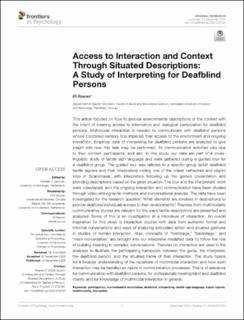| dc.contributor.author | Raanes, Eli | |
| dc.date.accessioned | 2021-09-14T08:23:57Z | |
| dc.date.available | 2021-09-14T08:23:57Z | |
| dc.date.created | 2020-12-16T09:35:43Z | |
| dc.date.issued | 2020 | |
| dc.identifier.citation | Frontiers in Psychology. 2020, 11 . | en_US |
| dc.identifier.issn | 1664-1078 | |
| dc.identifier.uri | https://hdl.handle.net/11250/2776377 | |
| dc.description.abstract | This article focuses on how to provide environmental descriptions of the context with the intent of creating access to information and dialogical participation for deafblind persons. Multimodal interaction is needed to communicate with deafblind persons whose combined sensory loss impedes their access to the environment and ongoing interaction. Empirical data of interpreting for deafblind persons are analyzed to give insight into how this task may be performed. All communicative activities vary due to their context, participants, and aim. In this study, our data are part of a cross-linguistic study of tactile sign language and were gathered during a guided tour for a deafblind group. The guided tour was tailored to a specific group (adult deafblind tactile signers and their interpreters) visiting one of the oldest cathedrals and pilgrim sites in Scandinavia, with interpreters following up the guide’s presentation and providing descriptions based on the given situation. The tour and the interpreters’ work were videotaped, and the ongoing interaction and communication have been studied through video-ethnographic methods and conversational analysis. The data have been investigated for the research question: What elements are involved in descriptions to provide deafblind individuals access to their environments? Theories from multimodality communicative studies are relevant for the ways tactile descriptions are presented and analyzed. Some of this is an investigation at a microlevel of interaction. An overall inspiration for this study is interaction studies with data from authentic formal and informal conversations and ways of analyzing embodied action and situated gestures in studies of human interaction. Also, concepts of “frontstage,” “backstage,” and “main conversation” are brought into our interpreter-mediated data to follow the role of building meaning in complex conversations. Theories on interaction are used in the analyses to illustrate the participating framework between the guide, the interpreter, the deafblind person, and the situated frame of their interaction. The study opens for a broader understanding of the repertoire of multimodal interaction and how such interaction may be handled as inputs in communication processes. This is of relevance for communication with deafblind persons, for professionals meeting blind and deafblind clients, and for knowledge of multimodal interaction in general. | en_US |
| dc.language.iso | eng | en_US |
| dc.publisher | Frontiers Media | en_US |
| dc.rights | Navngivelse 4.0 Internasjonal | * |
| dc.rights.uri | http://creativecommons.org/licenses/by/4.0/deed.no | * |
| dc.title | Access to Interaction and Context Through Situated Descriptions: A Study of Interpreting for Deafblind Persons | en_US |
| dc.type | Peer reviewed | en_US |
| dc.type | Journal article | en_US |
| dc.description.version | publishedVersion | en_US |
| dc.source.pagenumber | 15 | en_US |
| dc.source.volume | 11 | en_US |
| dc.source.journal | Frontiers in Psychology | en_US |
| dc.identifier.doi | 10.3389/fpsyg.2020.573154 | |
| dc.identifier.cristin | 1860344 | |
| dc.description.localcode | Copyright © 2020 Raanes. This is an open-access article distributed under the terms of the Creative Commons Attribution License (CC BY). The use, distribution or reproduction in other forums is permitted, provided the original author(s) and the copyright owner(s) are credited and that the original publication in this journal is cited, in accordance with accepted academic practice. No use, distribution or reproduction is permitted which does not comply with these terms. | en_US |
| cristin.ispublished | true | |
| cristin.fulltext | original | |
| cristin.qualitycode | 1 | |

